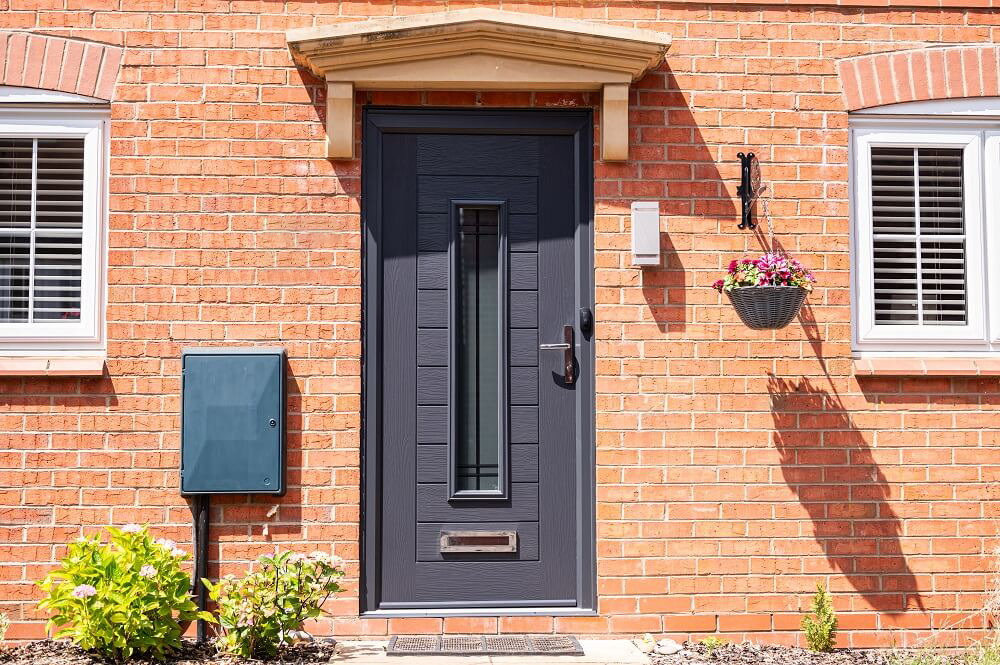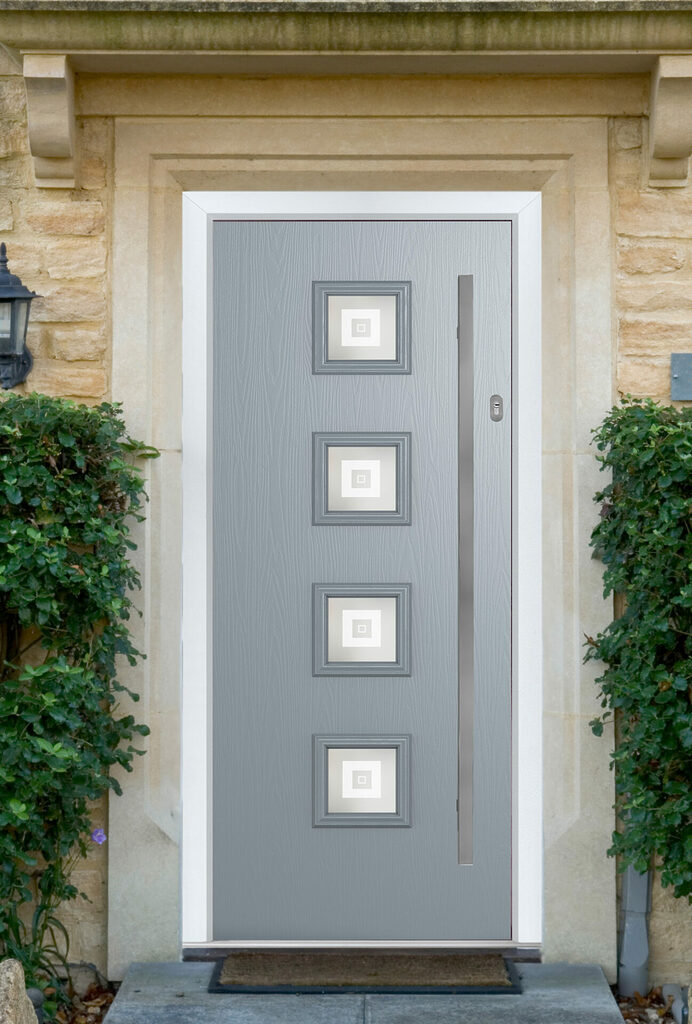Last Updated on 7 July 2025 by IanR
The most energy-efficient front doors are composite doors, timber doors, multi-chambered uPVC doors and aluminium composite doors.
With so many doors on the market, all offering different attributes, one of the most popular questions we get is which door is the most energy-efficient? In this post, we’ll be delving into the importance of having an energy-efficient front door, not only for the sake of cost-saving but also to enhance the comfort of your home. We’ll uncover the crucial aspects of selecting the right door type and ensuring its proper installation.

- Composite Doors: Made of multiple materials, such as uPVC, foam, glass-reinforced plastic, and wood, these doors excel in energy efficiency by effectively resisting heat transfer in both directions. Additionally, they offer durability and require minimal maintenance.
- Aluminium Composite Doors: Aluminium is known for its thermal conductivity, but modern aluminium front doors cleverly combine multiple materials to preserve excellent thermal efficiency. Surpassing the requirements of building regulations, these doors prove to be highly efficient and effective.
- Wooden Doors: Wooden doors, being natural insulators, effectively block heat transfer in both directions. They boast timeless aesthetics and come in a variety of styles. However, regular maintenance is necessary to preserve their appearance and durability.
- uPVC: uPVC stands out as a highly energy-efficient option. They possess robust and durable properties, ensuring they won’t warp or crack over time. The heavy-duty frame can withstand extreme weather conditions while maintaining indoor heat.
In conclusion, choosing an energy-efficient front door is a wise investment, and understanding the various door types and their attributes can help you make an informed decision for your home.
For a guide on the cost of a new front door, click here to read our article.
What Are U-values for Doors?
U-values for doors represent a measurement of their thermal performance and indicate how effective they are at preventing heat transfer. Lower U-values signify better insulation, making doors with lower U-values more energy-efficient as they help retain heat inside during colder months and keep the interior cooler during warmer periods. Understanding the U-values of doors is crucial for making informed choices when selecting energy-efficient options for your home.

What are the minimum energy efficiency standards for doors in the UK?
From June 2022, there was a new change in the minimum energy rating standard for doors to ensure compliance with the UK Building Regulations. The new standard mandates that doors must achieve a Door Energy Rating of C (equivalent to 1.4). This update aims to enhance the overall energy efficiency of homes, promoting sustainability and reducing energy consumption. Homeowners and builders will need to consider this new requirement when selecting doors to meet the revised energy efficiency standards in the UK.
The best energy efficient front doors
Timber Doors
Timber doors are highly regarded for their energy-efficient properties, offering several benefits that contribute to a more sustainable and comfortable living environment.
Natural Insulation: Wood, being a natural insulator, has inherent thermal properties that help regulate indoor temperatures. Timber doors effectively resist heat transfer, keeping the warmth inside during colder seasons and reducing heat penetration during warmer months.
Low U-values: U-values measure the rate of heat transfer through a material, with lower values indicating better insulation. Timber doors typically have favorable U-values, often ranging from 1.2 to 1.6 W/m²K, showcasing their energy-efficient capabilities.
By combining natural insulation, favorable U-values, and sustainability, timber doors provide an excellent solution for energy-conscious individuals seeking an environmentally friendly and energy-efficient option for their homes.
Composite Doors

With so many Comp Door styles and colours to choose from, there’s something for everyone.
Composite doors are highly regarded for their exceptional energy efficiency, making them a popular choice among homeowners looking to enhance their property’s sustainability. Here’s why composite doors excel in energy efficiency, along with their typical U-values:
Multi-layered Construction: Composite doors are composed of multiple layers of different materials, such as wood, uPVC, insulating foam, and glass-reinforced plastic (GRP). This combination of materials creates a highly efficient barrier against heat transfer, ensuring minimal energy loss.
Low U-values: U-values measure a material’s ability to prevent heat transfer, with lower values indicating better insulation. Composite doors typically have excellent U-values, often ranging from 1.4 to 1.8 W/m²K. These low U-values showcase the superior energy-saving capabilities of composite doors.
Enhanced Insulation: The insulating foam core within the composite door structure provides additional thermal resistance. This feature ensures that composite doors effectively keep the cold out during winter and maintain a cooler interior during hot summers.
For an ultimate guide to buying a composite door, click here.
Multi-chambered uPVC doors
Multi-chambered uPVC doors are renowned for their exceptional energy efficiency, making them a popular choice for homeowners seeking to reduce energy consumption and maintain a comfortable living environment. Here’s why multi-chambered uPVC doors excel in energy efficiency, along with their typical U-values:
Multiple Chambers: Multi-chambered uPVC doors are designed with several compartments or chambers within their frames. These chambers create barriers that trap air, acting as effective thermal insulators. The trapped air minimises heat transfer, keeping the interior warmer during colder months and cooler during warmer seasons.
Low U-values: U-values indicate a material’s capacity to resist heat transfer, with lower values signifying better insulation. Multi-chambered uPVC doors typically boast impressive U-values, ranging from 1.0 to 1.3 W/m²K. These low U-values demonstrate their superior energy-efficient properties.
Aluminium Doors

The Smart Signature aluminium composite door range is the epitome of cutting-edge craftsmanship and innovation.
Aluminium Composite doors are an excellent choice for energy efficiency, offering several features that make them a popular option among homeowners looking to reduce energy consumption and enhance thermal insulation. Here’s why aluminium front doors are energy-efficient, along with their typical U-values:
Thermal Break Technology: Modern aluminium front doors are engineered with thermal break technology, which involves inserting insulating materials between the interior and exterior parts of the door frame. This thermal barrier minimises heat transfer, ensuring that the doors maintain a comfortable indoor temperature and prevent energy loss.
Low U-values: U-values indicate a material’s ability to resist heat transfer, with lower values signifying superior insulation. Aluminium front doors with thermal break technology typically have impressive U-values, ranging from 0.8 to 1.6 W/m²K. These low U-values demonstrate their excellent energy-efficient properties.
Weather Resistance: Aluminium is naturally resistant to weather elements, making front doors made from this material highly durable and effective in preventing drafts and air leaks. Their weather-resistant properties contribute to maintaining a stable indoor climate.
FAQ’s about energy efficient front doors
What is the most energy-efficient exterior door material?
The most energy-efficient exterior door material is generally aluminium. Aluminium doors are renowned for their exceptional thermal insulation properties, making them highly efficient at preventing heat transfer. They effectively keep the interior warm during colder months and maintain a cooler temperature during warmer seasons. Additionally, aluminium doors are durable, weather-resistant, and require minimal maintenance, further contributing to their energy efficiency and long-term cost savings. When it comes to balancing energy efficiency, durability, and performance, aluminium doors stand out as the top choice for homeowners seeking an energy-efficient exterior door material.
What is the most insulated front door?
Composite doors often come out on top when searching for the most energy efficient door. This is down to their complicated manufacturing process and range of materials used to make them. The best way to choose which energy efficient door to go for is to compare their u-value ratings. We’d definitely recommend considering u-values over door materials when comparing energy efficiency.
Are composite doors more energy-efficient than uPVC?
Although composite doors are the more sophisticated choice, many individuals still opt for uPVC door installations. The primary advantage of choosing uPVC doors over composite doors is their lower cost, as uPVC doors tend to be more budget-friendly. However, if you can afford a slightly higher investment, we strongly recommend selecting a composite door. Composite doors offer superior security, thermal efficiency, and durability compared to uPVC doors, making them a worthwhile long-term investment for your home.
If you enjoyed this article, here are some others we think might be useful..
- Beat rising energy costs with a composite front door.
- What are the best composite front doors UK (2024)?
- Do composite doors warp?
- Introducing Smart Signature Aluminium front doors: the future of entrance doors is here.
- New year, new exterior door colours: Solidor unveils Pottery Blue, Pebble Grey & Granite Grey.

